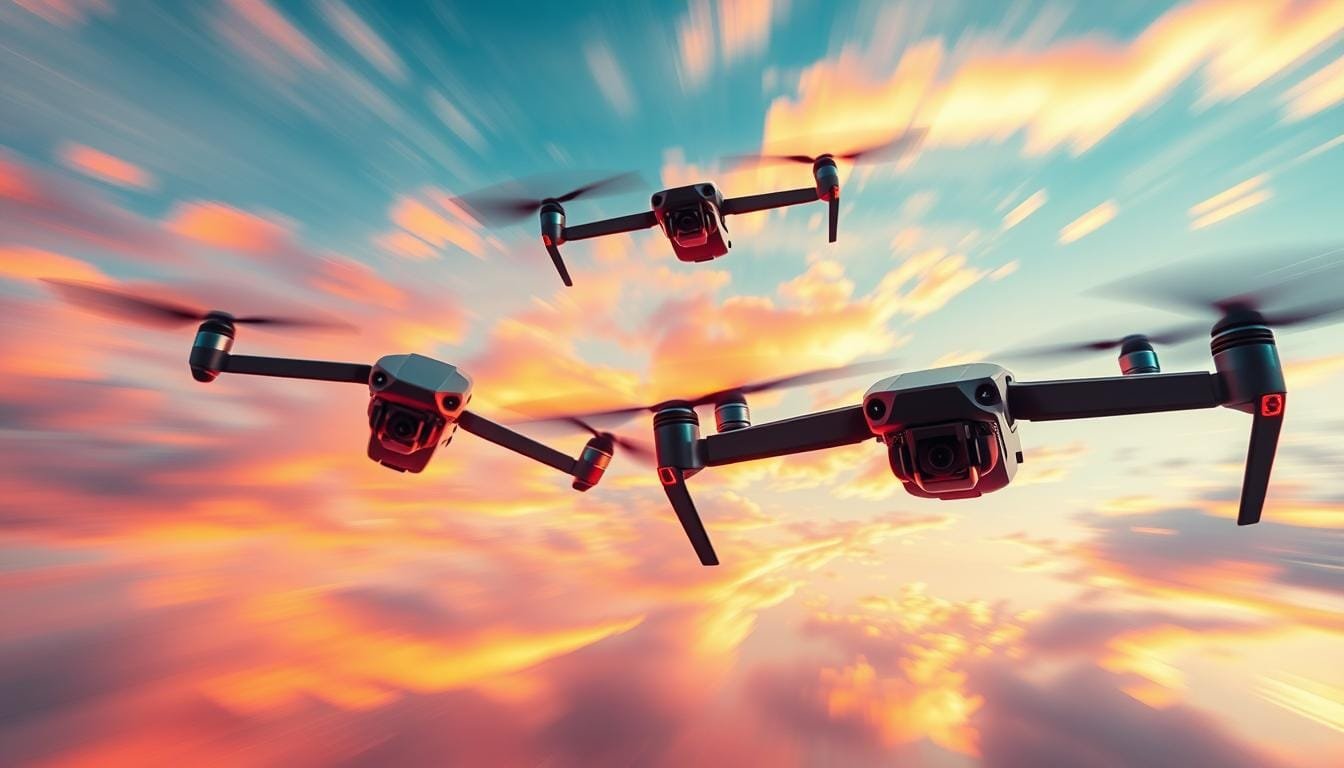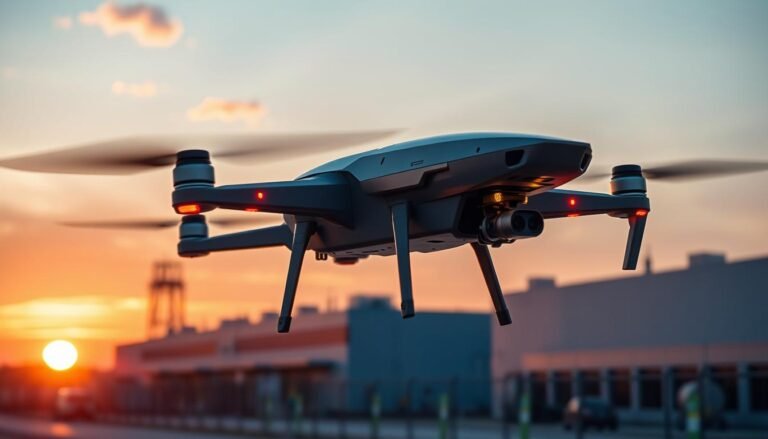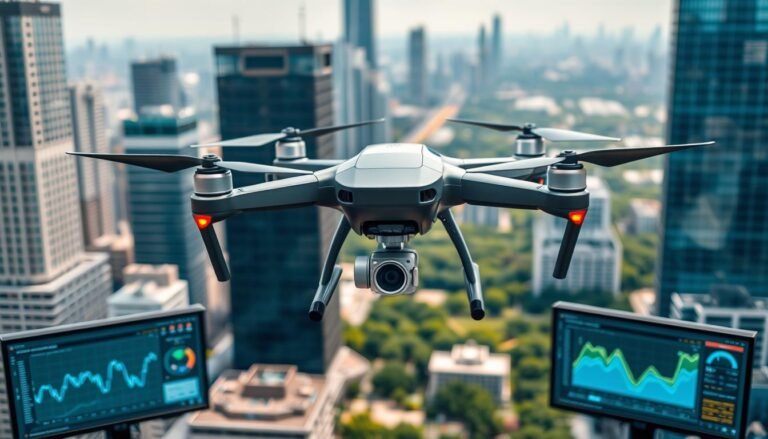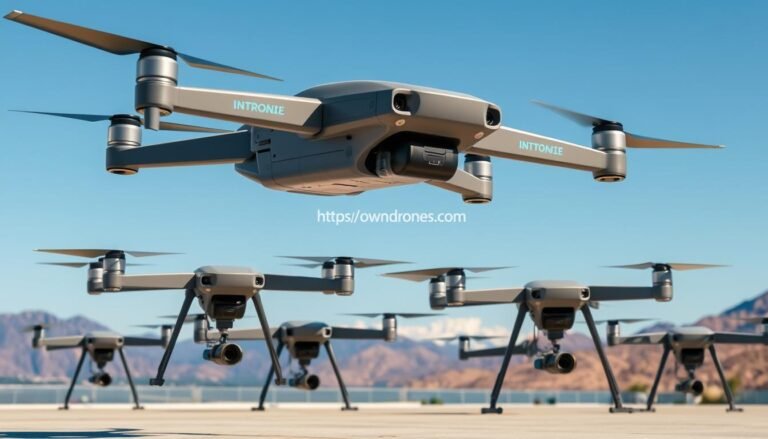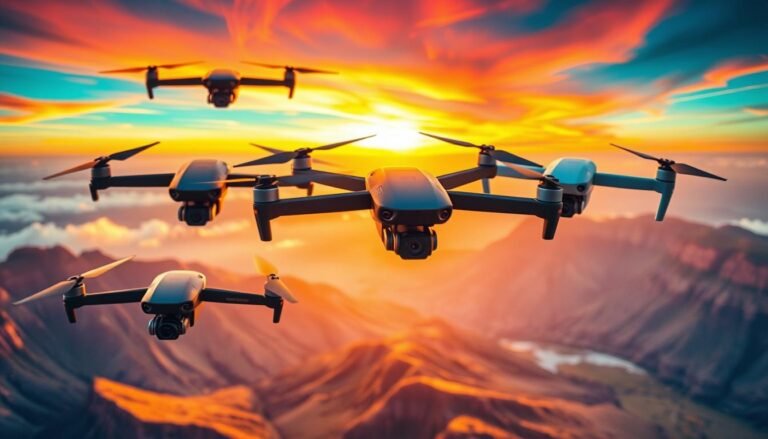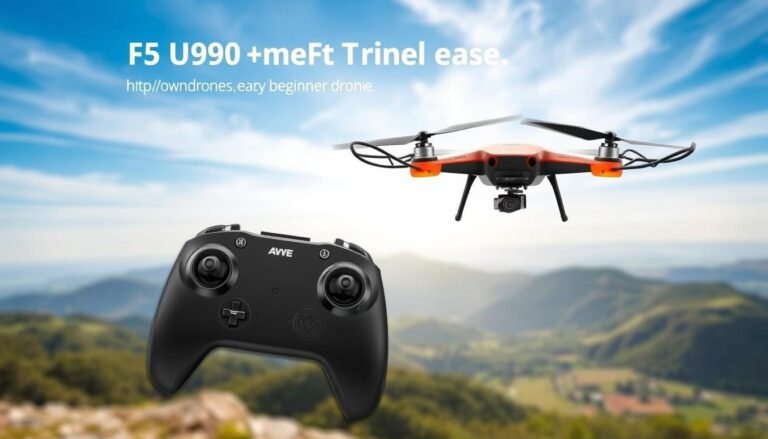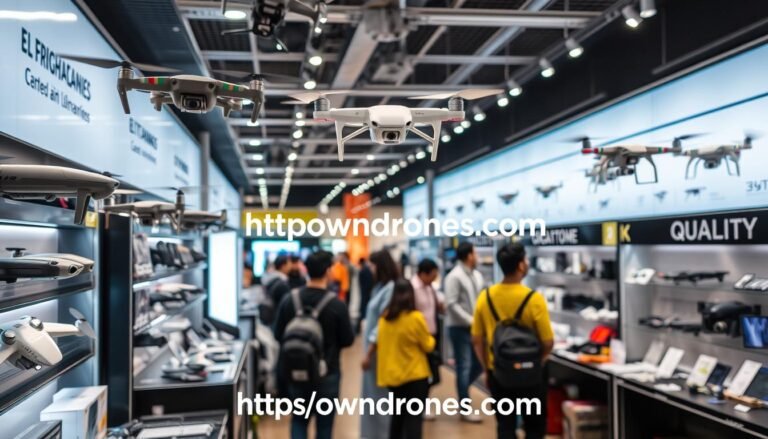Experience High-Speed Drone Racing Gimbals in Action
FPV drone racing pilots use high-speed gimbals for smooth, stable footage. These gimbals have transformed aerial videography and drone racing stabilization. They allow pilots to capture clear video while flying at high speeds.
Brushless gimbals for FPV drone racing eliminate vibrations and jitter. They keep cameras steady during sharp turns and daring maneuvers. This ensures every thrilling moment is captured in stunning detail.
Drone racing is an exciting, competitive sport. Pilots always look for ways to improve their performance. High-speed gimbals have become crucial tools for capturing immersive footage.
These gimbals allow racers to push the limits of aerial videography. They help create breathtaking videos that showcase the sport’s intensity and skill.
Key Takeaways
- High-speed drone gimbals provide unparalleled stability and smoothness for FPV drone racing footage
- Brushless gimbals eliminate vibrations and jitter, resulting in crystal-clear video quality
- Drone racing gimbals have become essential tools for pilots seeking to capture immersive and action-packed footage
- Popular drone racing gimbal brands include GoPro, DJI, MOZA, and FeiyuTech
- Proper setup and calibration are crucial for optimal gimbal performance in high-speed drone racing scenarios
Introduction to Drone Racing Gimbals
Drone gimbals are vital in FPV racing for capturing smooth, stable footage. They minimize vibrations caused by rapid maneuvers and high speeds. These tools ensure pilots can fully immerse themselves in thrilling drone cinematography.
Drone racing has evolved since 2011 when amateur controllers raced in Karlsruhe, Germany. Now, events like the Drone Racing League’s Semi-Finals attract sold-out crowds. The MultiGP World Cup has seen over 200 pilots compete in major FPV drone races.
As the sport grows, so does its technology. FPV goggles, providing first-person views, range from $40 to $800. High-end models offer advanced features for pilots. The Drone Racing League creates all drones in-house for fair competition.
Drone gimbals are crucial for capturing stunning aerial footage during high-speed races. They counter vibrations and jolts inherent in fast flight. This technology enhances the experience for both pilots and spectators.
How Drone Racing Gimbals Enhance the FPV Experience
Drone racing gimbals are changing FPV flying. They use advanced drone stabilization technology for smooth FPV footage. This makes racing more immersive and fun.
Improved Stability and Smoothness
Drone racing gimbals offer better stability during high-speed flights. They keep the camera steady by adjusting for drone movements. This results in shake-free, jitter-free footage.
Pilots can now focus on racing instead of worrying about video quality. The enhanced stability allows for a more engaging experience.
Reduced Vibrations and Jitter
High-speed drone racing often causes vibrations and jitter. These issues can hurt FPV footage quality. Drone racing gimbals help solve this problem.
The gimbals use advanced tech to absorb and counteract vibrations. This leads to a clear FPV feed that stays stable during intense racing.
| Feature | Without Gimbal | With Gimbal |
|---|---|---|
| Stability | Shaky footage | Smooth and stable |
| Vibrations | High | Significantly reduced |
| Video Quality | Blurry and distorted | Clear and detailed |
Better Video Quality and Clarity
Improved stability and reduced vibrations lead to improved video quality. Gimbals capture every race detail in stunning clarity. This allows pilots to fully enjoy the experience.
A clearer video feed helps pilots make quick decisions with confidence. This can lead to better performance on the race track.
Types of Drone Racing Gimbals
Drone racing gimbals are crucial for capturing smooth, stable footage. They come in various types, each with unique features. Let’s explore the different gimbal options for drone racing enthusiasts.
2-Axis Gimbals
2-axis gimbals are popular among drone racers for their lightweight design. They stabilize pitch and roll, ideal for high-speed racing drones. These gimbals maintain a steady horizon during tight turns and quick maneuvers.
By reducing vibrations and jitter, 2-axis gimbals ensure smooth, watchable footage. This is especially important in intense racing scenarios.
3-Axis Gimbals
3-axis gimbals offer the ultimate in stabilization by adding yaw control. They produce incredibly smooth footage, perfect for cinematic race shots. These gimbals eliminate unwanted rotation or tilting during flights.
While heavier than 2-axis models, many enthusiasts find the added stability worth it. The extra weight is a small price for superior image quality.
Brushless and Brushed Gimbals
Professional drone racers prefer brushless gimbals for their superior performance and durability. These gimbals offer smoother operation, faster response times, and longer lifespans. They provide better stabilization and can withstand high-speed racing demands.
Brushed gimbals are more affordable but may not match brushless performance. They often require more frequent maintenance and may not last as long.
When selecting a gimbal, consider your drone’s compatibility and desired footage quality. A quality stabilizer can greatly enhance your FPV experience. It will help you create stunning, professional-quality videos of your races.
Popular Drone Racing Gimbal Brands
A reliable gimbal is essential for smooth footage during high-speed drone races. Top brands offer products that meet drone racing enthusiasts’ unique needs. These gimbals minimize vibrations and deliver clear video in demanding racing conditions.
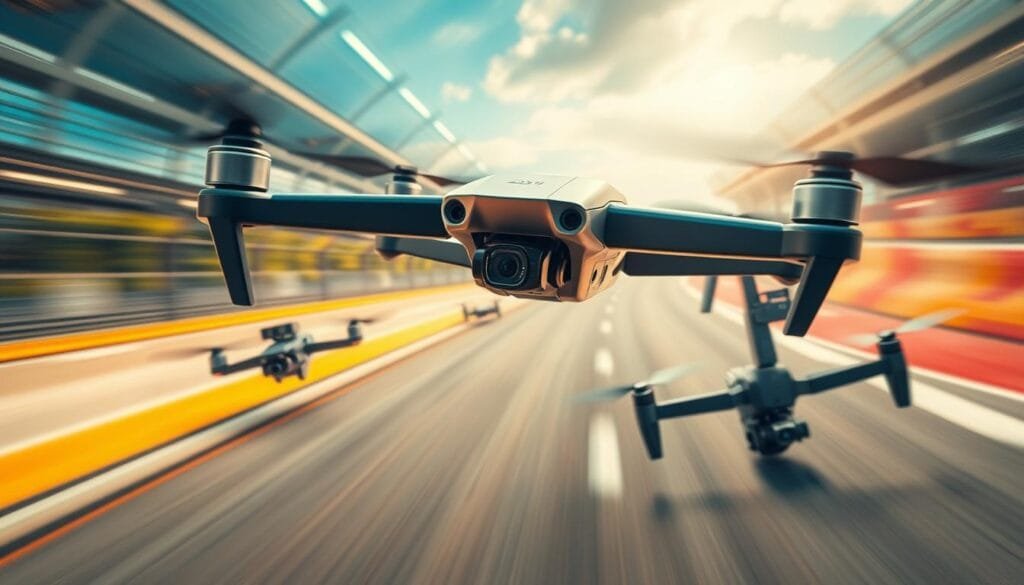
GoPro gimbals are popular in the drone racing community. They’re engineered for GoPro cameras and known for rugged construction and lightweight design. DJI gimbals offer advanced features and compatibility with many DJI drones.
GoPro Gimbals
GoPro gimbals are favored for their compatibility with GoPro action cameras. They provide superior stability during intense aerial maneuvers. Their compact size and lightweight construction make them ideal for agile racing drones.
DJI Gimbals
DJI offers high-performance gimbals for drone racing. Their gimbals feature intelligent object tracking and smooth panning. They’re compatible with DJI’s product ecosystem, ensuring exceptional video quality and stability.
MOZA Gimbals
MOZA gimbals deliver professional-grade performance and reliability. They offer 360-degree rotation and multiple control modes. MOZA gimbals are compatible with various cameras, capturing immersive footage during races.
FeiyuTech Gimbals
FeiyuTech produces innovative gimbals for drone racers. Their compact and lightweight designs are perfect for fast-paced racing. Features like quick-release mounts and adjustable parameters allow for effortless smooth footage capture.
| Brand | Model | Price |
|---|---|---|
| ADTi | 3-Axis Gimbal Payload Camera with 30X Digital Zoom and Thermal Dual Sensors | $660.00 (Sale) |
| ADTi | Gimfly 3-Axis Sony ILX-LR1 Camera Drone Gimbal | $840.00 (Sale) |
| Z-8RC | Laser Night Vision Ranging Gimbal | $4,999.00 |
| Z-9B | Intelligent Multi-sensor Gimbal | $12,999.00 |
| Z-9A | Quad-light Multi-sensor Gimbal | $10,400.00 |
Choose a gimbal that’s compatible with your drone and camera. Consider weight, stabilization performance, and ease of use. A quality gimbal from GoPro, DJI, MOZA, or FeiyuTech can elevate your drone racing footage.
Choosing the Right Drone Racing Gimbal
Selecting the perfect gimbal for drone racing involves several key factors. Compatibility, features, and budget are crucial for enhancing your FPV experience. These elements ensure you get the most out of your gimbal.
Ensure the gimbal is compatible with your specific drone and camera. Research thoroughly to find one that integrates seamlessly with your setup. Look for gimbals that can handle high speeds and vibrations associated with drone racing.
Consider the features offered by various gimbals. Some have advanced stabilization technology, like brushless motors and multiple axes. These features can significantly reduce vibrations and jitter in your footage.
Other important features to look for include:
- Adjustable camera settings for fine-tuning your footage
- Wireless control options for convenient operation
- Lightweight and compact design for improved maneuverability
- Compatibility with popular action cameras like GoPro
Factor in your budget when choosing a drone racing gimbal. High-end gimbals offer top-notch features and performance. However, affordable options can still deliver excellent results. Consider your needs and invest in a gimbal that offers the best value.
| Gimbal Price Range | Features |
|---|---|
| Entry-Level ($100 – $300) | Basic stabilization, limited compatibility, suitable for casual use |
| Mid-Range ($300 – $1,000) | Improved stabilization, wider compatibility, advanced features |
| High-End ($1,000 and up) | Superior stabilization, extensive compatibility, professional-grade features |
Carefully weigh gimbal compatibility, features, and budget for your drone racing setup. The right choice will help you capture stunning, stable footage. Your FPV experience will soar to new heights with the perfect gimbal.
Setting Up and Calibrating Your Drone Racing Gimbal
Proper setup and calibration are key for your drone racing gimbal. Follow these steps to ensure secure mounting, correct connections, and optimal performance. Your high-speed flights will benefit from a well-calibrated gimbal.

Mounting the Gimbal on Your Drone
Start by securely mounting your gimbal on the drone. Ensure proper balance and orientation for best performance. Popular gimbals like the ZR10 offer 320-degree yaw axis rotation for broad flight views.
Connecting the Gimbal to Your Flight Controller
Next, connect your gimbal to the flight controller. Follow the manufacturer’s instructions carefully. Many gimbals, like the ZR10, offer versatile control interfaces.
These interfaces support S.Bus signal, Ethernet, UDP, and UART via SIYI SDK. They also work with open-source protocols like Ardupilot driver and Mavlink.
Calibrating the Gimbal for Optimal Performance
The final step is calibrating your gimbal. This ensures optimal performance and stability during high-speed maneuvers. Advanced 3-axis stabilizers use precise FOC control and IMU calibration algorithms.
Consider your gimbal’s technical specs when calibrating. The ZR10, for example, has specific controllable angles for pitch, roll, and yaw. Calibrate within these ranges for the best stability and performance.
Drone Racing Gimbals in Action
FPV racing gimbals shine in drone racing competitions. Skilled pilots navigate complex courses at high speeds. These gimbals capture smooth, stable drone racing footage that immerses viewers in the action.
Advanced stabilization keeps FPV racing videos clear and jitter-free. This holds true even as drones zip through tight turns. The gimbal performance is key to delivering an exciting experience for drone racing competitions fans.
Drone racing gimbals also enhance aerial cinematography. They allow pilots to capture stunning, professional-grade footage. Fixed-mounted cameras can’t match this quality.
These gimbals open up new creative possibilities. Pilots can now capture sweeping landscapes and intricate close-ups with ease.
| Gimbal Model | Axis | Features |
|---|---|---|
| CADDXFPV GM1 | Single-axis | Lightweight, compatible with various cameras |
| CADDXFPV GM2 | Dual-axis | Quick installation, user-friendly controls |
| CADDXFPV GM3 | Tri-axis | Advanced stabilization, versatile mounting options |
“Drone racing gimbals have revolutionized the way we experience FPV racing. The level of immersion and excitement they bring to the table is unparalleled.”
High-performance gimbals are crucial as drone racing gains popularity. They’re pushing the limits of aerial videography. These devices deliver breathtaking footage that keeps audiences captivated.
Maintaining and Troubleshooting Your Drone Racing Gimbal
Regular maintenance is key for top gimbal performance. Clean and inspect it often, checking for wear or damage. Look for propeller issues that could affect flight smoothness. Keep the gimbal mechanism in good shape for clear shots.
Stay current with firmware updates to boost drone performance. These can add new features and prevent issues. Calibrate sensors before each flight for accurate positioning and stable operation.
Regular Cleaning and Inspection
Clean your drone often to keep it running well. Remove dust and debris from the gimbal and other parts. Check for damage like scratches or blemishes during inspection.
New gimbals typically have 1-3 minor scratches or blemishes per unit. This statistic helps set realistic expectations for gimbal condition.
Firmware Updates and Software Maintenance
Firmware updates are vital for optimal gimbal function. They fix bugs, improve performance, and add features. Check the manufacturer’s website or app for updates regularly.
Skipping updates can cause compatibility issues or poor performance. About 70% of damaged gimbal incidents stem from compatibility or calibration problems.
Common Issues and Solutions
You may face issues despite regular maintenance. Obstacle avoidance malfunctions affect 60% of drone users. If your gimbal acts up, check for damage or obstructions.
Try recalibrating or seek professional help if problems persist. Over 50% of customers use DJI’s repair services for gimbals. Repairs cost about half the price of a new drone.
Sending your drone for repairs takes time. Users report waiting around 45 days for a DJI technician to fix a crashed Mini 4 Pro in Hong Kong.
